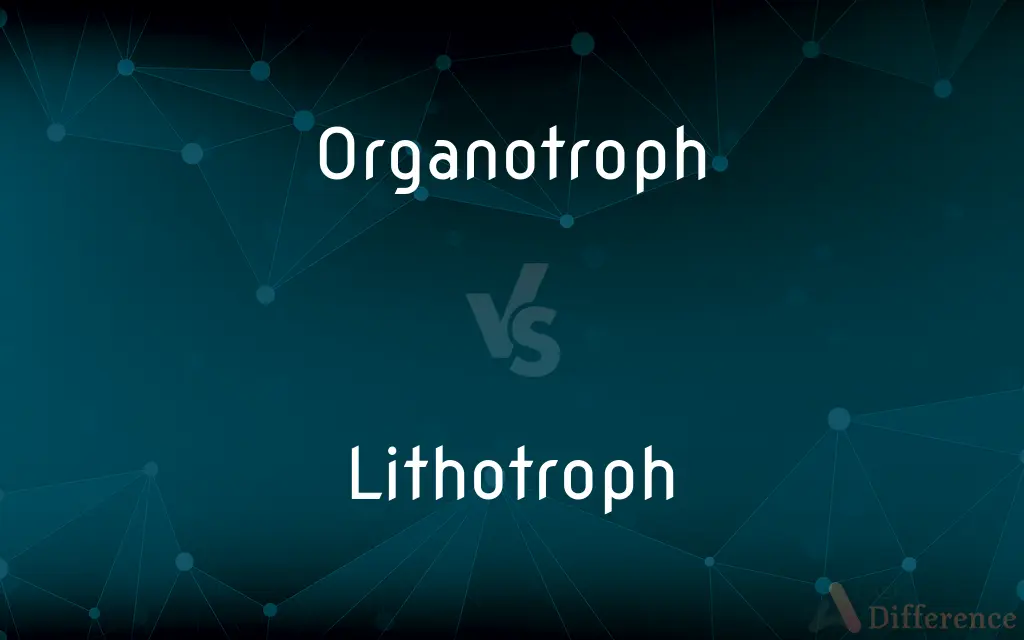Organotroph vs. Lithotroph — What's the Difference?
By Fiza Rafique & Urooj Arif — Updated on March 11, 2024
Organotrophs derive energy from organic compounds, whereas lithotrophs utilize inorganic substances.

Difference Between Organotroph and Lithotroph
Table of Contents
ADVERTISEMENT
Key Differences
Organotrophs are organisms that oxidize organic molecules, such as carbohydrates and fats, to obtain energy. They play a crucial role in the decomposition of organic matter and the cycling of nutrients within ecosystems. On the other hand, lithotrophs are characterized by their ability to use inorganic substrates, such as hydrogen, sulfur, or iron, to produce energy. This capability enables them to inhabit environments where organic compounds are scarce, contributing to the diversity of life forms and ecosystems.
Organotrophs are predominantly found among bacteria, fungi, and animals, including humans, highlighting their widespread presence across various habitats. These organisms are integral to food webs, serving as primary consumers, decomposers, or both. Whereas, lithotrophs, often bacteria and archaea, occupy specialized niches, such as deep-sea vents, hot springs, and soils, where they perform critical ecological functions like nitrogen fixation and sulfur cycling.
In terms of metabolism, organotrophs primarily rely on respiration or fermentation to extract energy from organic compounds, showcasing the versatility of their metabolic pathways. This diversity allows them to adapt to different environmental conditions and resource availability. Conversely, lithotrophs employ unique biochemical pathways, such as chemosynthesis, to convert inorganic compounds into energy, demonstrating the adaptability and resilience of life in extreme conditions.
The dependence of organotrophs on organic matter for energy makes them fundamental components of the carbon cycle, where they contribute to carbon fixation and release through respiration. In contrast, lithotrophs often play a key role in the biogeochemical cycling of elements, such as nitrogen and sulfur, by converting inorganic forms of these elements into forms that are usable by other organisms, thereby maintaining ecosystem balance and productivity.
One of the main distinctions between organotrophs and lithotrophs lies in their ecological roles and contributions. Organotrophs, by breaking down organic compounds, facilitate nutrient recycling and energy flow through ecosystems. Lithotrophs, however, are pivotal in making inorganic nutrients available and supporting life in extreme environments, underlining the complexity and interconnectedness of life on Earth.
ADVERTISEMENT
Comparison Chart
Energy Source
Organic compounds (carbohydrates, fats)
Inorganic substances (H, S, Fe)
Habitats
Widespread across various habitats
Specialized niches (deep-sea vents)
Role in Ecosystem
Decomposers, nutrient cycling
Nitrogen fixation, sulfur cycling
Metabolic Pathways
Respiration, fermentation
Chemosynthesis
Contribution to Cycles
Carbon cycle (carbon fixation, release)
Biogeochemical cycling (N, S)
Compare with Definitions
Organotroph
Key players in the decomposition process,
Fungi, as organotrophs, break down dead organic matter.
Lithotroph
Organisms that utilize inorganic substrates for energy.
Sulfur-oxidizing bacteria are lithotrophs.
Organotroph
Organisms that obtain energy from organic compounds,
Humans are organotrophs that consume carbohydrates for energy.
Lithotroph
Found in extreme environments.
Lithotrophs thrive in the hot springs of Yellowstone.
Organotroph
Part of the carbon cycle,
Organotrophs contribute to carbon release during respiration.
Lithotroph
Contribute to nitrogen fixation.
Certain lithotrophs convert atmospheric nitrogen into usable forms.
Organotroph
Rely on organic matter for energy,
Most animals are organotrophs, relying on food for energy.
Lithotroph
Essential for biogeochemical cycles.
Lithotrophs play a critical role in the sulfur cycle.
Organotroph
Involved in nutrient cycling,
Soil bacteria, organotrophs, facilitate the cycling of nutrients.
Lithotroph
Perform sulfur cycling.
Lithotrophs in deep-sea vents are involved in sulfur oxidation.
Organotroph
An organotroph is an organism that obtains hydrogen or electrons from organic substrates. This term is used in microbiology to classify and describe organisms based on how they obtain electrons for their respiration processes.
Lithotroph
Lithotrophs are a diverse group of organisms using an inorganic substrate (usually of mineral origin) to obtain reducing equivalents for use in biosynthesis (e.g., carbon dioxide fixation) or energy conservation (i.e., ATP production) via aerobic or anaerobic respiration. While lithotrophs in the broader sense include photolithotrophs like plants, chemolithotrophs are exclusively microorganisms; no known macrofauna possesses the ability to use inorganic compounds as electron sources.
Organotroph
(biology) An organism that obtains its energy from organic compounds.
Lithotroph
(biochemistry) An organism that obtains its energy from inorganic compounds (such as ammonia) via electron transfer.
Common Curiosities
What are organotrophs?
Organotrophs are organisms that obtain energy by oxidizing organic compounds.
What ecological roles do lithotrophs fulfill?
Lithotrophs are essential for nitrogen fixation and sulfur cycling.
What are lithotrophs?
Lithotrophs are organisms that derive energy from inorganic substances.
Where do organotrophs commonly live?
They inhabit a wide range of environments, from soil to human guts.
Do organotrophs participate in the carbon cycle?
Yes, they are integral to carbon fixation and release processes.
How do organotrophs contribute to the ecosystem?
They play a key role in decomposition and nutrient cycling.
Are fungi considered organotrophs?
Yes, most fungi are organotrophs, decomposing organic matter for energy.
What is the significance of organotrophs in food webs?
They serve as primary consumers and decomposers, facilitating energy flow.
Can lithotrophs survive in environments devoid of organic matter?
Yes, they can thrive in such environments by utilizing inorganic materials.
Are all bacteria organotrophs?
No, many bacteria are lithotrophs, using inorganic substances for energy.
How do lithotrophs affect the availability of nutrients?
They convert inorganic nutrients into forms usable by other organisms.
Can lithotrophs exist without sunlight?
Yes, they can generate energy without sunlight through chemosynthesis.
What is a key difference in the energy sources of organotrophs and lithotrophs?
Organotrophs use organic compounds, while lithotrophs rely on inorganic substances for energy.
Can lithotrophs be found in common environments?
While some can, many occupy extreme or specialized habitats.
What unique metabolic pathways do lithotrophs use?
Lithotrophs utilize chemosynthesis to convert inorganic compounds into energy.
Share Your Discovery

Previous Comparison
Surfactant vs. Emulsifier
Next Comparison
Owe vs. OwnAuthor Spotlight
Written by
Fiza RafiqueFiza Rafique is a skilled content writer at AskDifference.com, where she meticulously refines and enhances written pieces. Drawing from her vast editorial expertise, Fiza ensures clarity, accuracy, and precision in every article. Passionate about language, she continually seeks to elevate the quality of content for readers worldwide.
Co-written by
Urooj ArifUrooj is a skilled content writer at Ask Difference, known for her exceptional ability to simplify complex topics into engaging and informative content. With a passion for research and a flair for clear, concise writing, she consistently delivers articles that resonate with our diverse audience.
















































